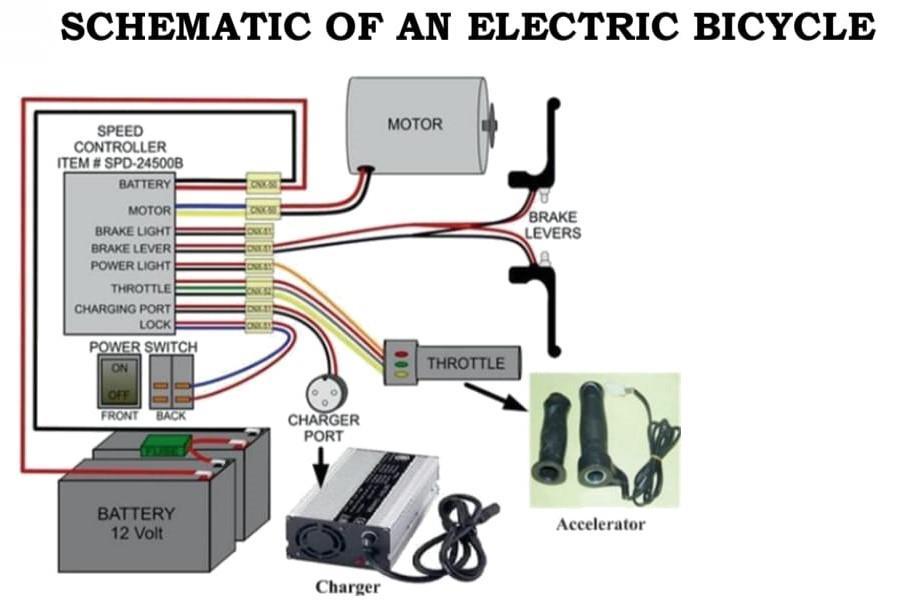
International Research Journal of Engineering and Technology (IRJET) e-ISSN: 2395-0056
Volume: 12 Issue: 05 | May 2025 www.irjet.net p-ISSN: 2395-0072


International Research Journal of Engineering and Technology (IRJET) e-ISSN: 2395-0056
Volume: 12 Issue: 05 | May 2025 www.irjet.net p-ISSN: 2395-0072
Shlok Kumar Srivastava1 , Nainshy Kumari Gupta1 , Sarita Prajapati1, Vikas Yadav1 , Mr. Ashish Kumar Srivastava2
1 B. Tech Mechanical Engineering final year, Goel Institute of Technology &Management, Lucknow 2 Assistant Professor, Department of Mechanical Engineering, Goel Institute of Technology &Management, Lucknow
Abstract - This project presents a comprehensive study and innovativedesignofasolar-poweredelectric bicycleaimedat promoting sustainable, cost-effective, and efficient urban transportation. By comparing traditional bicycles and conventional vehicles across key parameters such as cost, powerefficiency,accessibility,andenvironmentalimpact,the electricbicycleemergesasasuperiorsolution,particularlyfor short-distance and intra-city travel. The design integrates renewable energy through solar power, a regenerative chargingsystem using wheel friction,andsmart featuressuch as a flexible seat for all user weights, corrosion-resistant materials, and a multifunctional handlebar with storage and device-charging capabilities. The project highlights both the theoretical and practical aspects of electric bike components, emphasizing performance, energy efficiency, and user comfort paving the way for next-generation eco-friendly mobility.
Key Words: ElectricBicycle,SustainableTransportation, Solar Power Integration, Regenerative Charging, Urban/Rural Mobility, Energy Efficiency, Eco-friendly Design,SmartBicycleFeatures.
1.INTRODUCTION
Theelectricbicycle(e-bicycle)representsaprogressivestep toward solving modern environmental and economic transportationchallenges.Designedtoreducepollutionand promoteenergyefficiency,e-bicyclesofferasustainableand economicalalternativetotraditionalvehicles.Operatingona rechargeable battery coupled with an electric motor, ebicycles provide a low-maintenance, eco-friendly mode of transportation that is ideal for short-distance and urban travel.
Thisprojectfocusesonthedevelopmentofaninnovativeebicycle model that integrates practical and user-friendly features. Key innovations include the use of corrosionresistant materials for durability, a flexible seat to accommodate users of various body weights for enhanced comfort, and a smart balancing design for improved mobility. Additionally, a regenerative charging system utilizing rubber padding friction with the road surfacehelpsrechargethebatterywhileriding.Thee-bicycle alsoincludesasmarthandlebarstoragesystemforcarrying essentialslikephonesandkeys,withbuilt-inUSBcharging
fromthebike'sbattery.Theseenhancementsaimtomake thee-bicyclenotjustameansoftransport,butapractical, efficient,andsustainablemobilitysolutionforthefuture
1.1 Key Features
1.Eco-FriendlyTransportation
Operatesonarechargeablebattery,reducingairandnoise pollutioncomparedtofuel-poweredvehicles.
2.Energy-EfficientDesign
UsesaBLDCmotorforoptimizedpowerconsumptionand smoothoperationduringshortandurbancommutes.
3.RegenerativeChargingSystem
Innovativerubberpaddingsystemgeneratespowerthrough friction,rechargingthebatterywhileriding.
4.DurableandCorrosion-ResistantFrame
Built with materials that withstand environmental wear, ensuringlong-termreliabilityandlowmaintenance.
5.UniversalComfortSeating
Flexibleseatdesignaccommodatesridersofvaryingweights, offeringcomfortandbalance.
6.SmartStorageandConnectivity
Handlebar-integratedstoragesystemwithUSBchargingport formobilephonesandBluetoothdevices.
7.LowMaintenanceandCost-Effective
Minimalservicingneedsandreducedfueldependencymake iteconomicallypracticalfordailyuse.
8.User-CenteredDesign
Designedwithurbanmobilityinmind,offeringconvenience, safety,andadaptabilityformodern

International Research Journal of Engineering and Technology (IRJET) e-ISSN: 2395-0056
Volume: 12 Issue: 05 | May 2025 www.irjet.net p-ISSN: 2395-0072
Theprimaryobjectiveofthisprojectistodesignanddevelop aninnovative,user-friendly,andsustainableelectricbicycle thataddressesmoderntransportationchallengesrelatedto pollution, energy consumption, and urban mobility. The projectaimsto:
1. Promote Eco-Friendly Transportation by reducing dependencyonfossilfuelsthroughtheuseofrechargeable battery-poweredmotors.
2.EnhanceUserComfortandAccessibilitywithfeatures likeaflexibleseatadaptabletoallbodytypesandasmart balancingsystemforimprovedstability.
3.IncorporateRegenerativeEnergySolutionsthrougha friction-basedchargingmechanismthathelpsextendbattery lifewhileriding.
4. Improve Practical Utility by integrating a smart handlebarstoragesystemandUSBchargingcapabilitiesfor personaldevices.
5. Ensure Durability and Cost-Effectiveness using corrosion-resistant materials and low-maintenance components.
6.SupportUrbanMobilityNeedsbyprovidingacompact, efficient,andaffordablealternativetotraditionalvehiclesfor short-distancetravel.
Throughtheseobjectives,theprojectseekstocontributetoa more sustainable and convenient future for urban transportation.
Everyday,thesungivesusahugeamountofenergycalled solarenergy.Infact,thesungivesoffmoreenergyinoneday thanthewholeworldusesinayear.Thisenergycomesfrom deepinsidethesunthroughaprocesscallednuclearfusion, wherehydrogenturnsintoheliumandproducesheatand light.Ittakesjustovereightminutesforsunlighttotravel the 93 million miles from the sun to Earth. Solar energy travels very fast at the speed of light (about 3 lakh kilometrespersecond).Eventhoughonlyasmallpartofthe sun’s energy reachesEarth, itisstill more than enough to meetallourenergyneeds.Becausesunlightcomeseveryday and doesn’t run out, solar energy is called a renewable energy source. Today, people use it to heat water, warm homes, and make electricity. However, even though solar energy hasmany benefits,it currently makesup lessthan onepercentofthetotalenergyusedinsomecountrieslike theU.S.Mostsolarenergyisusedinhomesandtogenerate powerforelectricity.
1.UrbanandCityCommuting
Idealfordailytravelwithincities,reducingtrafficcongestion andpollutioninhigh-densityareas.
2.CollegeandUniversityCampuses
Providesstudentsandstaffwithaneco-friendly,affordable, andefficientmodeofon-campustransportation.
3.Last-MileConnectivity
Bridgesthegapbetweenpublictransportationhubsandfinal destinations,enhancingoveralltransportefficiency.
4.TourismandLeisureRides
Suitable for recreational use in parks, resorts, and scenic trails, offering a fun and environmentally conscious riding experience.
5.DeliveryandCourierServices
Acost-effectivesolutionforshort-distancedeliveryinurban areas,especiallywithsmartstorageintegration.
6.HealthandFitnesswithAssistiveSupport
Encourages physical activity while providing electric assistanceforelderlyorlessphysicallyactiveindividuals.
7.CorporateandIndustrialCampuses
3. PREVIOUS WORK
Herearenotablepreviousworksonelectricbicycleprojects, highlighting their innovators, titles, summaries, and publicationdetails:
1.DesignandFabricationofElectricBike
Innovators: ShwetaV.Matey,D.R.Prajapati,KunjanShinde, A.Mhaske
Summary: Thisstudyfocusesondesigningandfabricating anelectricbikepoweredbyabattery,withconsiderations for integrating solar energy. It emphasizes improved fuel economy,performance,andreducedpollutioncomparedto conventionalvehicles.
Published In: ResearchGate,March2017
2. Design and Fabrication of Foldable Electric and Solar PoweredBike
Innovators: Shikhar Sharma, Arun Kumar, Kapil Gyawali, DibashBhandari
Summary: Thispaperpresentsthedesignofalightweight, foldable electric bicycle integrated with solar panels for charging.Thegoalistocreateauser-friendly,zero-emission, andeconomicallyviabletransportationsolutionforurban areas.
Published In: ResearchGate,May2024

International Research Journal of Engineering and Technology (IRJET) e-ISSN: 2395-0056
Volume: 12 Issue: 05 | May 2025 www.irjet.net p-ISSN: 2395-0072
Innovators: RanjanKumar,MunnaKumar,PradyumnSah, MustaimAlam,Prof.Dr.M.AsokRajKumar
Summary: Thispaperdiscussesthecreationof a batteryoperatedcycleasanalternativetofuel-consumingvehicles, aiming to reduce environmental hazards and promote sustainabletransportation.
PublishedIn: InternationalJournalofEngineeringResearch &Technology(IJERT),April2018
4.FabricationofSelf-ChargingElectricBike
Innovators: Ilyas Hussain, Adithyakumar, Srirenga Venkatesh,SatheeshKumar
Summary: Thisprojectintroducesa self-charging electric bikeusingaDCmotor/generatorattachedtotherearwheel. Itfeaturestwobatterysetsthatalternatebetweenpowering thebikeandcharging,enhancingmileageandefficiency.
Published In: ResearchGate,May2021
5.DesignandFabrication(Development)ofE-Bike
Innovators: K. Sai Chandu, G.M.V Siva Kumar, Kannaji, B. KiranKishore,P.RamaKrishna
Summary: Thispaperoutlinesthedevelopmentofane-bike incorporatingaBLDChubmotor,battery,dynamo,throttle, andLEDlights, aimingtoaddress pollution and fossil fuel scarcity.
Published In: International Journal of Advance Research, IdeasandInnovationsinTechnology(IJARIIT),March2019
Thesestudiescollectivelycontributetotheadvancementof electric bicycle technology, focusing on sustainability, efficiency,andadaptabilitytourbantransportationneeds.
4. PROPOSED WORK
Building upon the innovative concepts outlined in the introduction,theproposedworkaimstodesignanddevelop anelectricbicyclethatemphasizessustainability,durability, andusercomfort.Theprojectwillfocuson:
1.MaterialInnovation:
Utilizing corrosion-resistant materials to enhance the bicycle’s lifespan and reliability in various weather conditions.
2.ComfortandAccessibility:
Designingaflexibleseatingsystemthatadaptstodifferent rider weights and promotes ergonomic support during travel.
3.EnergyRegeneration:
Implementing a regenerative charging mechanism using rubberpaddingthatgeneratespowerthroughfrictionwith
theroad,increasingbatteryefficiencyandreducingtheneed forexternalcharging.
4.SmartFeaturesIntegration:
DevelopingahandlebarstoragesystemequippedwithUSB charging ports to power mobile devices and Bluetooth connectivity,enhancinguserconvenience.
5.MobilityandStabilityEnhancements:
Incorporating a smart balancing design to improve rider stability and safety, especially in urban commuting scenarios.
6.SustainableUrbanMobilitySolution:
Creatinganeco-friendly,cost-effective,andpracticalelectric bicycle that addresses the growing demand for green transportationalternatives,particularlyforshort-distance andinner-citytravel.
Thisprojectaimstoproduceawell-roundedelectricbicycle prototypethatnotonlymeetscurrenttransportationneeds butalsosetsanewstandardforfuturesustainablemobility solutions.
The methodology for developing the innovative electric bicycle described in the introduction involves several systematicstepstoensurethedesignmeetssustainability, efficiency,andusercomfortobjectives:
1.DesignandMaterialSelection:
Selectcorrosion-resistantmaterialsforthebicycleframeand componentsto ensuredurabilityand reduce maintenance needs.
Design a flexible seat using ergonomic principles to accommodateridersofvaryingweightscomfortably.
2.MechanicalandElectricalSystemIntegration:
Integrate a rechargeable battery with a suitable electric motor (such as a BLDC motor) to provide efficient propulsion.
Developasmartbalancingmechanismtoenhancestability duringriding.
3.RegenerativeChargingSystemDevelopment:
Implement a rubber padding system on the wheels that createsfrictionwiththeroadsurfacetogenerateenergyand recharge the battery while in motion, contributing to extendedbatterylifeandsustainability.
4.SmartHandlebarStorageDesign:
Designacompacthandlebar-mountedstoragecompartment withintegratedUSBchargingportsformobilephonesand Bluetoothdevices,poweredbythee-bicycle’sbattery.

International Research Journal of Engineering and Technology (IRJET) e-ISSN: 2395-0056
Volume: 12 Issue: 05 | May 2025 www.irjet.net p-ISSN: 2395-0072
5.PrototypeFabricationandAssembly:
Manufactureandassembletheselectedcomponentsintoa functionalprototype,ensuringproperalignment,wiring,and ergonomics.
6.TestingandPerformanceEvaluation:
Conduct tests to evaluate battery efficiency, motor performance, balancing stability, and comfort under differentridingconditions.
Measure the effectiveness of the regenerative charging systemandthedurabilityofcorrosion-resistantmaterials.
7.OptimizationandIteration:
Based on test results, refine design elements and system integrationforimprovedperformance,energyefficiency,and userexperience.
This methodology ensures a comprehensive approach to developinganelectricbicyclethatispractical,efficient,and alignedwithmoderntransportationneeds.
1.FrameandMaterials:
Constructthebicycleframeusingcorrosion-resistantmetals (such as aluminum alloy or stainless steel) to ensure durabilityandweatherresistance.
2.SeatingSystem:
Installaflexible,ergonomicseatdesignedwithcushioning materialscapableofadaptingtodifferentriderweightsfor enhancedcomfortduringrides.
3.ElectricDriveSystem:
Mountarechargeablelithium-ionbatteryandabrushlessDC (BLDC)motorconnectedviaachainorhubmotorassembly toprovideefficientpropulsion.
Includeamotorcontrollerandthrottlemechanismforspeed regulation.
4.RegenerativeChargingMechanism:
Attachrubberpaddingunitsaroundthewheelrimsortires designed to create friction with the road surface during motion.
Connectthesepaddingstoageneratorcircuitthatconverts frictional energy into electrical energy to recharge the batterywhilethebicycleisinuse.
5.SmartHandlebarStorage:
Equipthehandlebarwithacompactstoragecompartment fitted with USB ports powered by the battery system, allowingchargingofphonesandBluetoothdevicesonthego.
6.BalancingandStability:
Incorporate sensors or a mechanical design feature to enhance the bicycle’s balance, improving rider safety and easeofmaneuvering.
7.InstrumentationandMonitoring:
Integratebasicmonitoringtoolslikeavoltmeter,ammeter, and speedometer to track battery status, power consumption,andspeedduringtestruns.
8.TestingEnvironment:
Performtrialsonvariedterrainstypicalofurbanandshortdistance travel routes to evaluate performance, comfort, batterylife,regenerativechargingefficiency,andhandling.
9.DataCollectionandAnalysis:
Recorddataonenergyconsumption,chargingratesfromthe regenerative system, rider comfort feedback, and overall bicycleperformanceforfurtheroptimization. This setup provides a comprehensive platform to experimentallyvalidatethekeyfeaturesandinnovationsof theelectricbicycle,ensuringitmeetstheproject’sgoalsfor sustainability,efficiency,anduser-friendliness.
Thesolar-powered electric bicycleoperates bycombining renewableenergygeneration,efficientelectricpropulsion, and user-centric design features into a cohesive transportationsystem.Solarpanelsmountedonthebicycle harnesssunlightandconvertitintoelectricalenergy,which isstoredinarechargeablebatterythatpowersabrushless DC motor to assist the rider during travel. Additionally, a regenerativechargingmechanismuseswheelfrictionviaa rubber padding system to generate supplemental energy whileriding,enhancingoverallefficiency.Thebikeincludes a flexible seat that adjusts to various body weights for increased comfort, corrosion-resistant materials for durability,andamultifunctionalhandlebarequippedwith storage space and USB ports for charging devices. These integratedfeaturesworktogethertodeliverapractical,costeffective, and eco-friendly alternative to traditional urban transportation.


Table:1BOM
solar panel (50W–100W), lightweight, weatherresistant
(preferred for efficiency) or PWM, compatible with solar andbatteryspecs
Lithium-ion, 36V/48V, 10Ah–20Ah, rechargeable, long cyclelife
Storage Compartment (on frame/handleb ar) For tools, mobile devices,smallitems 1 Safety & Electricals Lighting System LED front and rear lights, connected to mainpowersupply
–750W dependingonterrain& use-case)
WiringHarness Proper gauge, waterproofconnectors 1set
Fuses / Protection Circuitry Inlinefuseorresettable breakers As need ed
Mechanical or hydraulicdiscbrakes 2
Table:2ComponentDescription
Component Description
GPS Tracker / IoT Module Real-time tracking or smart city integration
Bluetooth / Wi-Fi Module Formobileappconnectivity
Removable Battery Dock Foreasycharging/swapping
Anti-theftLockSystem Integrateddigitalormechanicallock
1.EnhancedStabilityforAllRiders
A self-balancing system can make electric bicycles more accessible for elderly users, people with disabilities, and beginnersbyreducingtheriskoftippingover.
2.IntegrationofSolar-PoweredGyroscopicSensors
Use of compact, solar-powered gyroscopes and accelerometerstomonitorbalanceandadjustthevehicle’s centerofgravityinrealtime.
3.EnergyEfficiencythroughSolarPanels
Integration of flexible or foldable solar panels on the bike frameorwheelstopowerthebalancesystemindependently, reducingbatterydependencyandincreasingrange.

International Research Journal of Engineering and Technology (IRJET) e-ISSN: 2395-0056
Volume: 12 Issue: 05 | May 2025 www.irjet.net p-ISSN: 2395-0072
4.AI-BasedBalancingAlgorithms
ImplementationofAItopredictimbalancesduetoterrainor usermovementsandmakeintelligentreal-timecorrections.
5.SmartSuspensionSystem
A solar-assisted smart suspension system that adjusts the damping based on road conditions and balance data for smootherrides.
The solar-powered electric bicycle project offers a smart, eco-friendly, and affordable solution for short-distance urbantravel.Bycombiningrenewableenergy,regenerative charging,anduser-friendlyfeatures,itprovesmoreefficient and sustainable than traditional bicycles or vehicles. This innovativedesignsupportstheshifttowardgreenerurban mobilityandhighlightsthepotentialofelectricbicyclesin futuretransportationsystems.
1.Priyanka,S.,Tharun,S.,Aswath,M.,&Archana,A.(2023). Pedal-Power Assist Bicycle Design and Implementation. KuppamEngineeringCollege,AndhraPradesh,India.
2.Singh,Y.,&Verma,A.(2021).Designanddevelopmentof solar-powered electric bicycles. International Journal of RenewableEnergyResearch,11(3),1452-1461.
3. Zhang, T., Li, Y., & Wang, H. (2020). Smart balancing systemfor electricbicyclesusinggyroscopiccontrol.IEEE TransactionsonIntelligentTransportationSystems,21(9), 3874–3883.
4. Kumar, R., & Gupta, P. (2019). Regenerative braking in electricvehicles:Acomprehensivereview.EnergyReports, 5,1449–1465.
5. Tan, W., & Zhao, L. (2022). Lightweight composite materials for sustainable vehicle design. Materials Today: Proceedings,56,105–112.
BIOGRAPHIES

Shlok Kumar Srivastava
B.Tech Mechanical Engineering
FinalYearStudent GITM,Lucknow




Nainshy Kumari Gupta
B.Tech Mechanical Engineering
FinalYearStudent
GITM,Lucknow
Sarita Prajapati
B.Tech Mechanical Engineering
FinalYearStudent
GITM,Lucknow
Vikas Yadav
B.Tech Mechanical Engineering
FinalYearStudent
GITM,Lucknow
Mr. Ashish Kumar Srivastava
Assistant Professor , Department ofMechanicalEngineering, Goel Institute of Technology and Management,Lucknow